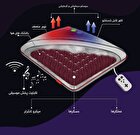Iranian Scientists Develop Solar Sensors to Determine Position, Orientation of Satellites

“Solar sensors are one of the most important instruments to determine the position and orientation of satellites and spacecraft. These navigation tools are used to detect the position of the sun,” Ahmad Soleimani, a commercialization expert at the Iranian Space Research Center, told ANA.
He added that by using the sensor, the solar arrays of spacecraft are always placed in the most optimal position to the main source of power, i.e. the sun, and this increases the efficiency of the power generation system.
“High accuracy, low weight and low power consumption make this sensor a superior tool in navigation. Solar sensors with 18% accuracy, plus and minus 70 degrees range of view, maximum power consumption of 150 miliwatts, weight of 60 grams and operating temperature of minus 20 to plus and minus 60 degrees Celsius play an important role in determining the position and orientation of satellites and spacecraft. The lifespan of these sensors is expected to be 5 years,” Soleimani said.
He noted that increasing the efficiency of various types of solar arrays in different kinds of navigation systems (land, air and sea) is one of the important applications of these sensors.
“Renewable energy industries, military and law enforcement forces, meteorological organization, air and marine industries are among the potential customers of solar sensors,”Soleimani said.
In a relevant development in August, Iranian researchers at Sahand University of Technology in Tabriz had also succeeded in developing a simple, low-cost and scalable method for the synthesis of perovskite solar cell light-absorbing layers, considering the country’s serious need to have access to low-cost and renewable energy sources.
“Perovskite solar cells are the latest generation of solar cells that have surpassed previous technologies due to rapid progress in efficiency and performance,” said Farzad Nasirpouri, a professor of the Department of Materials Engineering of Sahand University of Technology.
“Like any other technology, one of the most important challenges in developing such cells is the ability to produce them on a large and industrial scale. To this end, a simple and scalable chemical bath method was developed in our project for the synthesis of perovskite layer. The solar cell made by this method showed an efficiency of 11.35% under standard radiation conditions,” he added.
"The results of this project showed the possibility of preparing perovskite by the chemical bath method, which on the one hand eliminates the need to use hazardous solvents, and on the other hand, because it is simpler and less expensive, it is possible to generalize to large dimensions,” Nasirpouri said.
Noting that the project has been implemented on a laboratory scale, he said, “Due to the fact that the immersion method in a chemical bath (Chemical Bath Deposition) can easily be converted to an industrial scale and also in the proposed process, one of the toxic solvents to prepare the perovskite layer has been omitted, it can be used for industrial production after going through the necessary steps.”
4155/v
























